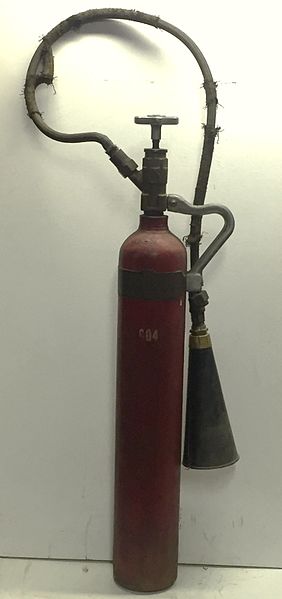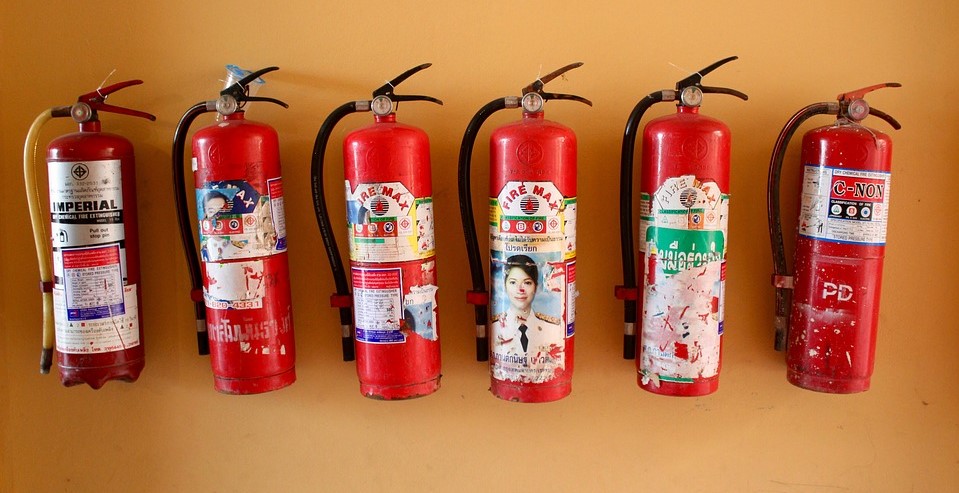Fire extinguisher
Contents |
[edit] Introduction
Fire extinguishers are portable apparatus used to put out small fires in emergency situations. They work by distributing a suitable extinguishant (such as liquid, foam, powder and so on) onto the burning material to cut off its supply of oxygen or suppress the chemical reaction occurring in the flame.
[edit] History
The earliest forms of fire extinguisher were introduced in the Middle Ages. These devices, known as squirts, were pump-like devices with nozzles on the end.
The nozzle of the pump would be put into water, and a plunger would be used to pull the water into the squirt. The nozzle was then aimed at the fire, and the water stream would be directed towards the fire.
In 1723, Ambrose Godfrey was awarded the first official patent for a fire extinguisher. The German-born British chemist was best known for his production of phosphorus, but in 1724, he published a document entitled ‘New Method of Extinguishing Fires by Explosion and Suffocation’. His idea was to design a machine consisting of a cask of an aqueous solution surrounding a pewter chamber of gunpowder. The idea behind this was that a series of fuses would be detonated which would then make the gunpowder explode and distribute the liquid.
The first portable fire extinguisher was invented in 1819 by Captain George William Manby. His device consisted of a copper vessel containing a solution of potassium carbonate and compressed air.
Other early examples included:
- 1866 sodium bicarbonate and sulphuric acid with water
- 1904 chemical foam of sodium bicarbonate and aluminium sulphate.
- 1912 carbon tetrachloride (CTC).
- 1924 carbon dioxide.

|
| The 1924 carbon dioxide extinguisher invented by the Walter Kidde Company was made to put out fires in telephone switchboards. The device consisted of a metal cylinder with a wheel valve and a brass hose covered with cotton. The extinguisher in this photograph was made by the Walter Kidde Company for Bell Telephone in 1928. |
[edit] Fire extinguisher categories
In the UK, fire extinguishers are included in the standard BS EN 3 - Portable fire extinguishers. The extinguishers are colour coded to indicate which type of fires they should be used to extinguish:
- Water = Red
- Foam = Red with cream panel above the operating instructions
- Dry powder (generally a mix of monoammonium phosphate and ammonium sulfate, but not for combustible fires) = Red with blue panel above the operating instructions
- Carbon dioxide = Red with black panel above the operating instructions.
- Wet chemical (generally containing potassium acetate with potassium citrate or potassium bicarbonate) = Red with a bright yellow panel above the operating instructions.
- Class D powder (generally a mix of monoammonium phosphate and ammonium sulfate, but only for combustible fires) = Red with blue panel above the operating instructions.
[edit] Six fire classes
The UK recognises six fire classes:
- Class A fires involve organic solids such as paper and wood.
- Class B fires involve flammable or combustible liquids, including petrol, grease and oil.
- Class C fires involve flammable gases.
- Class D fires involve combustible metals.
- Class E fires involve electrical equipment/appliances.
- Class F fires involve cooking fat and oil.
| Class A | Class B | Class C | Class D | Class E | Class F | |
| Water | Yes | |||||
| Foam | Yes | Yes | ||||
| Dry powder | Yes | Yes | Yes | Yes | ||
| Carbon dioxide | Yes | Yes | ||||
| Wet chemical | Yes | Based on situation | Yes | |||
| Class D powder | Yes |
While the powder inside fire extinguishers is non-toxic, contact should be limited. Precautions should be taken to minimise incidents where these circumstances could occur.
[edit] Maintenance
Fire extinguishers should be checked and maintained on a regular basis. While it’s uncommon for a device to have an expiration date, its reliability can degrade over time if it has not been properly maintained.
In the UK, there are three types of required maintenance:
- Basic. Annual service and inspection
- Extended. Five year test discharge and recharge.
- Overhaul: 10 year test for CO2 extinguishers.
[edit] Related articles on Designing Buildings Wiki
Featured articles and news
Infrastructure that connect the physical and digital domains.
Harnessing robotics and AI in challenging environments
The key to nuclear decommissioning and fusion engineering.
BSRIA announces Lisa Ashworth as new CEO
Tasked with furthering BSRIA’s impressive growth ambitions.
Public buildings get half a million energy efficiency boost
£557 million to switch to cleaner heating and save on energy.
CIOB launches pre-election manifesto
Outlining potential future policies for the next government.
Grenfell Tower Inquiry announcement
Phase 2 hearings come to a close and the final report due in September.
Progress from Parts L, F and O: A whitepaper, one year on.
A replicated study to understand the opinion of practitioners.
ECA announces new president 2024
Electrical engineer and business leader Stuart Smith.
A distinct type of countryside that should be celebrated.
Should Part O be extended to existing buildings?
EAC brands heatwave adaptation a missed opportunity.
Definition of Statutory in workplace and facilities management
Established by IWFM, BESA, CIBSE and BSRIA.
Tackling the transition from traditional heating systems
59% lack the necessary information and confidence to switch.
The general election and the construction industry
As PM, Rishi Sunak announces July 4 date for an election.
Eco apprenticeships continue help grow green workforce
A year after being recognised at the King's coronation.
Permitted development rights for agricultural buildings
The changes coming into effect as of May 21, 2024.






















